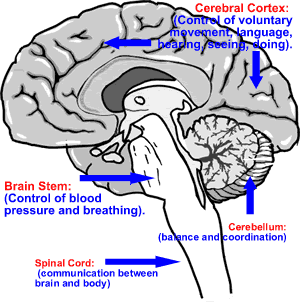|
CEREBRAL EDEMA; BRAIN SWELLING Any tissue in the body that has been injured will respond with an inflammatory response. Inflammation the bodies mechanism to recover from trauma, low levels of oxygen (ischemia), infection or any other form of tissue injury. The inflammatory response attempts to get more blood to the area of injury. It will also initiate changes to the microscopic circulation (circulation that is too small to be seen without a microscope) that will help white blood cells, protein and other nutrients reach the area of injury. Blood flow to the area is increased, and the blood vessels become "leaky", causing water to leak from the blood vessels and into surrounding tissue. This accumulation of water is called "edema" or swelling. When the brain has suffered an injury for any reason, the inflammatory response will cause water to collect in the brain tissues. This collection of water in the brain is called Cerebral Edema or Brain Swelling. Brain swelling can occur following stroke for any reason, as a result of infection, trauma or low blood flow and oxygen levels. If you break your arm, the arm will also swell. Swelling in the arm is different from the brain because the tissues have more room to expand. The skin around your arm is able to swell. The brain is shielded from minor injury by the skull bone. The skull creates a solid round "closed box" that extends underneath to completely enclose your brain. The only significant "opening" in the box is a large hole in the bottom that allows your spinal cord to connect to the brain (Image 1). While the design of the skull is usually protective, it is also becomes the major cause for problems when the brain is severely injured (Image 2). An injured brain will swell, but there is very room for the swollen brain to expand. Cerebral edema is an extremely serious and life-threatening problem. It can be very difficult to stop once it starts because the swelling causes more and more injury to the brain. If the swelling becomes uncontrollable, the pressure inside the "closed box" will increase. This is called "Raised Intracranial Pressure" or "Intracranial Hypertension". It may be helpful with certain types of brain injury to measure the pressure inside the brain with a special catheter called an intraventricular catheter. The pressure inside the brain is called the Intracranial Pressure or ICP. Patients who experienced raised intracranial pressure will usually have some degree of brain damage. It the swelling can be controlled quickly, the damage may be minor and the patient could have a good recovery of function. This is more common when the brain is young. Raised intracranial pressure carries a very high likelihood that the individual will have very serious brain damage. If the Intracranial Pressure continues to rise, it will become harder and harder for blood to flow toward the brain. This will cause more damage to the brain, which will cause more swelling. Eventually the entire brain can die from a lack of blood flow. If the entire brain dies, "clinical brain death" has occurred. |
Image 1: The skull creates a hard, round shell that encases the brain. It can be both our protector and our nemesis when brain injury occurs. |
|
Image 2: The red line represents the closed-box and limited ability for the brain to swell. |
|
|
Image 3: Area of brain function. |
Image 3: Area of brain function. |
|
|
Last Reviewed: October 23, 2014






